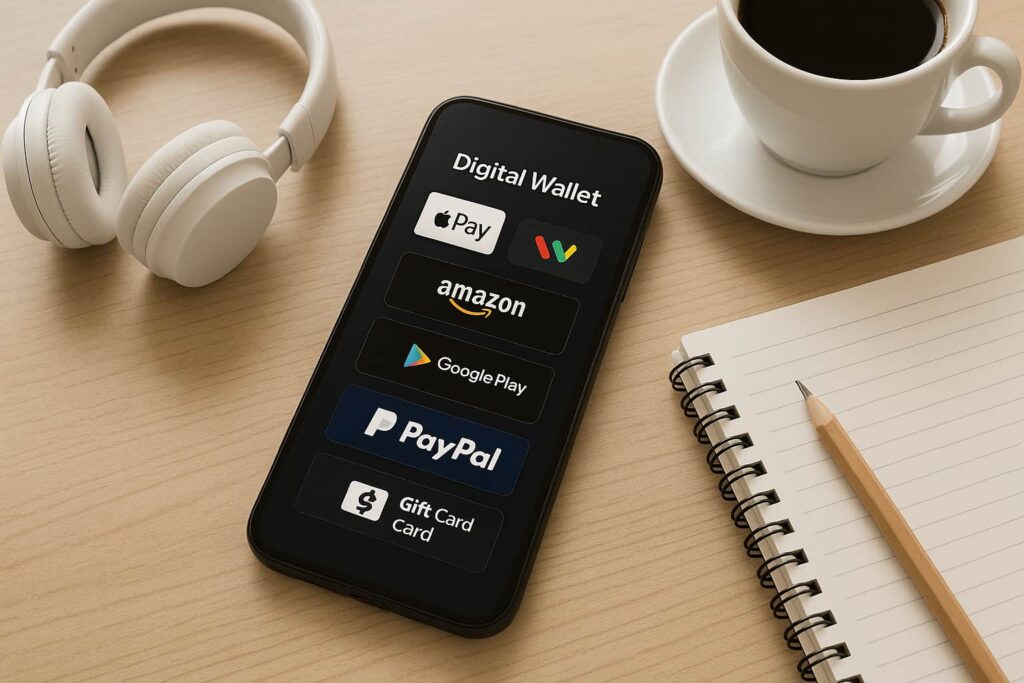
The way Americans pay for their digital lives is quietly shifting. What was once the territory of credit cards and direct bank links is now being reshaped by micro-rewards, prepaid balances, and digital gift cards folded into wallets like Apple Pay and Google Wallet. At the heart of this change is Generation Z — a cohort of students, homemakers, gig workers, and young professionals who are redefining how everyday spending is managed online.
For this generation, the value is not just in the size of the balance but in the control it provides. A $10 or $20 prepaid card may sound small, but when stacked inside a wallet, it becomes a safe, trackable way to manage subscriptions, gaming credits, cloud storage, and even food delivery. The rise of digital wallets combined with gift cards reveals something deeper: a generational shift in trust, budgeting, and convenience.

The Gen Z preference for prepaid balance over credit
Unlike earlier generations, Gen Z entered adulthood during a period of economic uncertainty. Many of them saw parents struggle with debt, or they faced rising student loan costs themselves. That experience has made them skeptical of credit-based systems. Instead of swiping cards with hidden interest or unexpected charges, they prefer prepaid balances that are fixed, immediate, and disposable.
Gift cards in particular, from Amazon to Google Play, have become a bridge between earning apps, rewards platforms, and mainstream spending. Students redeem surveys for codes, homemakers watch short ads for payouts, and casual workers refer friends for bonus credits. Those small codes then move into wallets, giving the user the power to decide exactly when and how to spend them.
This shift is also about psychology. A prepaid balance feels like free digital money, even if it was earned through time or engagement. That mental difference explains why adoption rates are climbing.
Micro-rewards as a mainstream payment rail
According to Statista data, nearly 65% of Americans under 25 use a digital wallet weekly. Within that group, surveys suggest more than 40% have redeemed or purchased a gift card in the past 60 days. This means gift cards are no longer secondary payment methods; they are quietly becoming primary micro-payment rails.
The advantage is obvious: gift cards settle instantly. There is no pending transaction or risk of chargeback. Once a code is redeemed, the balance is active and ready to use. That makes them particularly useful for low-ticket items like app subscriptions, mobile games, or media rentals.
Platforms such as FreeGiftZone play into this system by offering users the chance to claim a free Google Play redeem code. Once claimed, that code can be added to Google Wallet and used directly at checkout, just like cash. The flow is fast, transparent, and avoids the need to type in bank details on every app or website.
Everyday spending patterns
Gift cards inside wallets are most commonly used for four categories of spending:
-
Streaming services – Netflix, Hulu, Disney+, Spotify, and YouTube Premium.
-
Gaming credits – Minecoins in Minecraft, V-Bucks in Fortnite, and Call of Duty Points.
-
Productivity tools – Cloud storage upgrades on Google Drive, design apps like Canva, and student-friendly platforms such as Grammarly.
-
Shopping utilities – Small Amazon purchases, food delivery apps, or even eBooks.
Each category has one thing in common: low recurring costs. A $5 or $10 gift card balance may not sound like much, but for a subscription fee of $6.99 or $9.99, it’s enough to cover an entire month. That makes these small balances extremely powerful in the daily lives of Gen Z users.
Why this matters to businesses
From a corporate perspective, the trend is a double-edged sword. On one hand, it simplifies consumer adoption. Offering prepaid gift codes removes friction from sign-ups and lets businesses tap into younger demographics who may not use credit cards. On the other hand, it reduces long-term subscription lock-in, because the user may only top up when they have balance available.
Still, most businesses see the upside. By integrating with wallets and gift card systems, companies can capture new users who would otherwise be excluded from digital commerce. For example, game publishers frequently partner with rewards platforms to offer in-game credits as redeemable gift cards. Streaming services do the same by selling one-month prepaid passes.
The trend also supports employee benefits and loyalty schemes. Instead of cash bonuses, many companies now distribute small-value gift cards as perks. They are easy to deliver digitally, cost-controlled, and flexible for recipients.
The role of rewards platforms
Rewards platforms sit at the centre of this ecosystem. By bridging consumer engagement with brand payouts, they effectively mint the gift card balances that Gen Z later spends. A typical flow looks like this:

-
A student completes a 10-minute survey.
-
They earn coins inside the platform.
-
Coins are converted to a $5 Google Play card.
-
The card is redeemed inside Google Wallet.
-
The student uses the balance to pay for a productivity app or game credit.
What looks like a tiny loop at the individual level scales into millions of micro-redemptions every month across the U.S. For platforms like FreeGiftZone, which focus on practical, small-value payouts, the goal is to maintain transparency, show redemption history clearly, and keep codes working reliably.
Risks and safeguards
As with any trend, there are risks. Fake gift card generators, phishing emails, and scam websites continue to target young users. Industry experts recommend three basic safeguards:
-
Always redeem codes directly on official platforms such as Google Play or Amazon.
-
Never share gift card PINs or details through email or text.
-
Verify balances inside the wallet app immediately after redemption.
By following these steps, users can protect themselves from most of the common fraud attempts in the space.
Looking forward
The rise of digital wallets filled with gift card balances is not a passing fad. It reflects a generational preference for security, control, and micro-level budgeting. Over time, this behavior could reshape how digital businesses structure their pricing and rewards. Instead of chasing credit-linked loyalty, brands may design systems that accept and even encourage prepaid balances as a mainstream payment method.
For Gen Z, the future of spending may not be about large accounts or long-term commitments. It may be about stacking small, earned balances — a few dollars here, ten dollars there — and folding them seamlessly into wallets that run their digital lives.
FAQ
1. Why do Gen Z prefer gift cards inside digital wallets?
They prefer prepaid balances because they provide security, avoid bank linkages, and help manage small recurring costs without overspending.
2. Can gift cards replace credit cards for everyday use?
Not entirely. Gift cards are great for subscriptions, games, and small shopping needs, but they don’t work everywhere credit cards are required.
3. How does FreeGiftZone fit into this trend?
Platforms like FreeGiftZone issue small-value codes, including free Google Play redeem codes, which users redeem inside wallets. This makes prepaid rewards accessible to students, homemakers, and budget-conscious households.
4. Are there risks in using gift cards?
Yes. Fake generators, phishing links, and scams exist. It is important to redeem only on official sites and keep gift card details private.
5. Will other demographics follow this habit?
Yes. While Gen Z leads adoption, older age groups are also adopting prepaid digital balances, especially for gifting and employee benefits.



